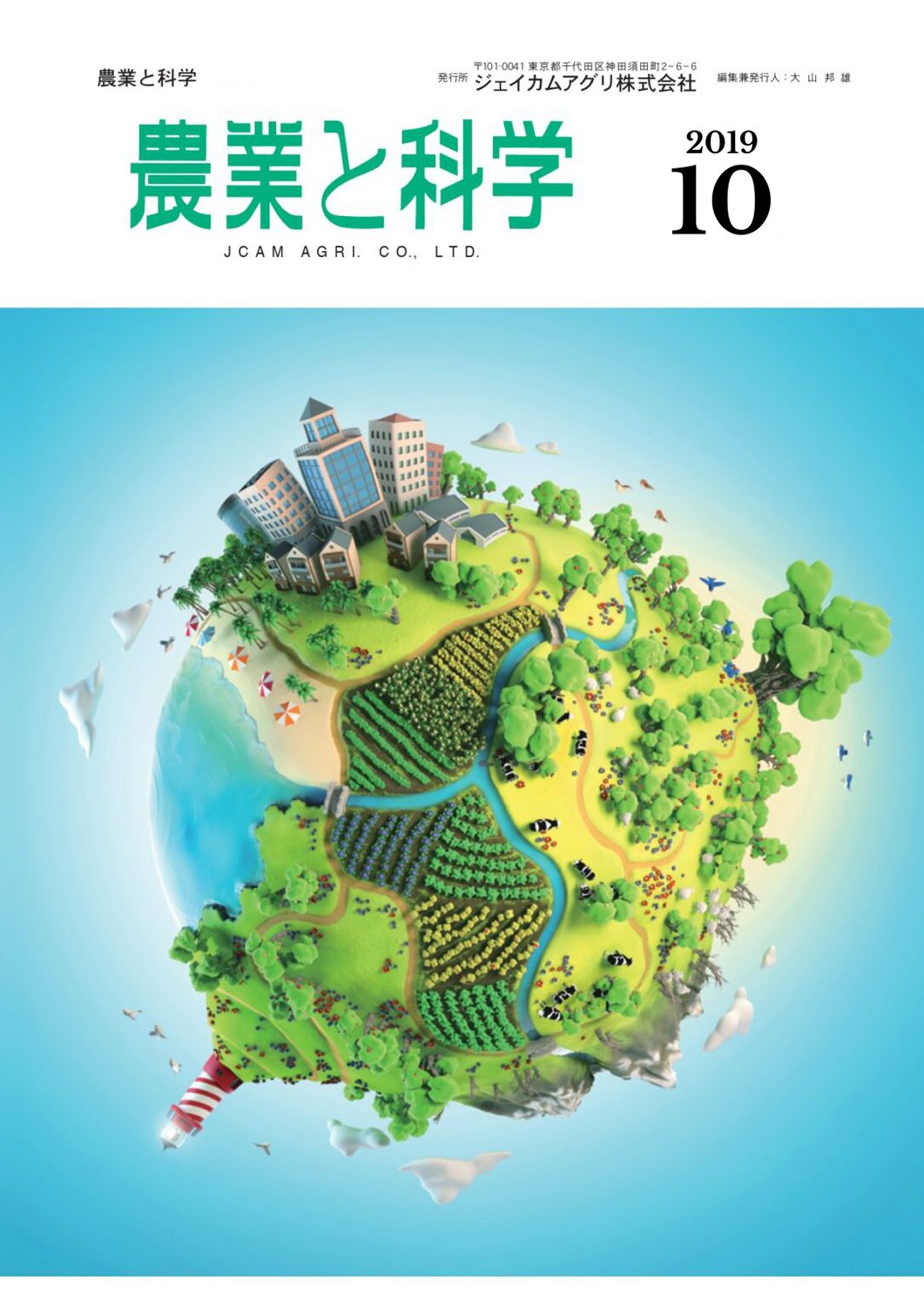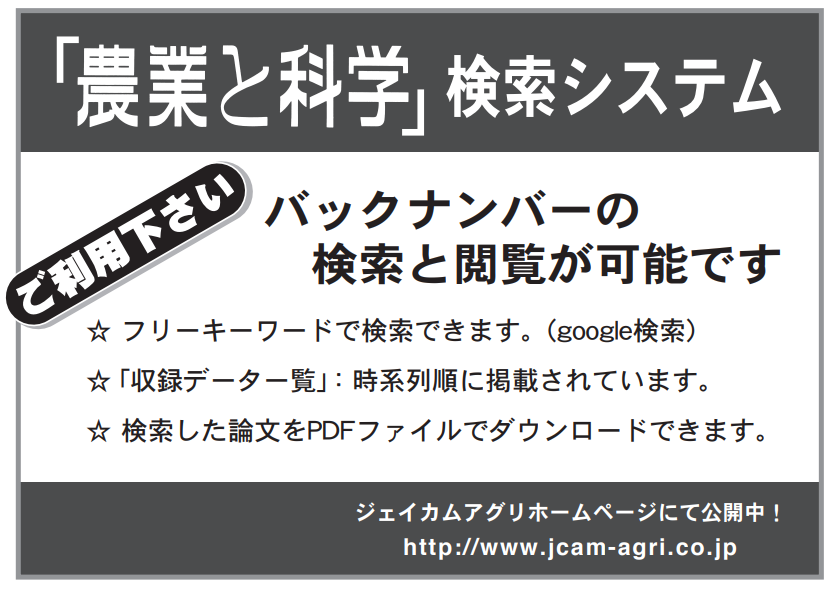

Site Search
Search within product
No. 714 Published 2019 (R1) .10
Click here for PDF version
Agriculture and Science 2019/10



The Science of Seeing the Invisible -Application to the Field of Agricultural Science
Fukushima University, Faculty of Agriculture, Department of Food and Agricultural Sciences
教 授 平 修
Introduction
The world of modern science has shown the tremendous power of "seeing (showing)" data. Rather than using new technology to show them, many of the methods used are slightly modified versions of classical analytical methods. In other words, it is a change of mindset. In this paper, we introduce the principle and application of Imaging Mass Spectrometry (IMS), which is a new way of "seeing" mass spectrometry, especially in the field of agriculture. It is a great honor for me to write this manuscript on IMS. The author is currently serving as a faculty member at Fukushima University, School of Agricultural Sciences, Department of Food and Agricultural Sciences, which will open in 2019. Thankfully, the first class of students (108 students) will be studying there from April 2019.
The "Faculty of Food and Agricultural Sciences" also has "seeing" as one of the pillars of its research, and I would like to introduce it in the form of an interactive dialogue.
Moderator: Inaho Mizuta (Minister in charge of Onigiri)
Speaker: Sakuzo Hata, Professor of Agriculture, Fukushima University
(Characters are fictional.)

(water-filled) paddy field My name is Inaho Mizuta, Minister in charge of Onigiri, and on the occasion of the approval for the establishment of Fukushima University, Faculty of Agriculture, Department of Food and Agricultural Sciences in April 2019, I would like to talk with Professor Sakuzo Hata of the Department of Food and Agricultural Sciences about the characteristics of the Department. Thank you, Professor Hata.
birthplace Best regards.
(water-filled) paddy field Now, let's start with the approval for the establishment of the Department of Food and Agricultural Sciences, which Dr. Hata says is very epoch-making, but some people say that the contents are still not clear. Let me get straight to the point! What kind of department is it?
birthplace Let me answer your question. The Department of Food and Agricultural Sciences is to scientifically prove the production of food necessary for our survival, and to disseminate new, socially beneficial "food" and "agriculture" research originating from Fukushima. This is what the Department of Food and Agricultural Sciences is all about.
(water-filled) paddy field But, do you think that the Department of Food and Agricultural Sciences is a university where you learn how to farm?
birthplace No, it is not. As shown in Figure 1, the Department of Food and Agricultural Sciences combines agriculture and science to find a scientific basis for all agricultural phenomena. For this purpose, we have assembled a wide range of faculty members from breeding, environment, food, and business administration.

Fields and paddy fields Run through the laboratory and the farm!
birthplace We have also made "seeing" research one of the pillars of the department. For this purpose, we have installed a mass spectrometer (Fig. 2), the first in Tohoku and the fourth in Japan, which enables high-speed imaging as well as omics analysis. Our goal is to conduct outstanding research and education.

(water-filled) paddy field However, "seeing" and "eating" are not really connected.
birthplace For example, the main component of rice, which is the staple food of the Japanese people, is starch. Furthermore, rice also contains functional ingredients. However, no matter how many scientific tables and graphs are presented to us, we just wonder if this is true. Of course, there is no lie in that.
(water-filled) paddy field Yes.
birthplace Now let's look at rice in IMS. Looking at Figure 3, which do you think looks healthier?

(water-filled) paddy field Oh, this shows us that the rice produced in Fukushima Prefecture is excellent. Seeing is believing!
The best way to do this is to use the
birthplace That's right. This is a comparison of brown rice (produced in Fukushima Prefecture) grown by organic farming and that grown by conventional farming.
(water-filled) paddy field So there are many functional ingredients in the surrounding area of brown rice. It is easy to understand why brown rice is considered healthy.
birthplace Yes, I have. In both types of rice grains, functional components such as arginine, vitamin E, and oryzanol are localized in the bran layer and the germ site. And in the case of organic farming, they are also localized in the endosperm. The difference in the localization of functional components due to different cultivation methods adds value to the food.
(water-filled) paddy field Now that I look at it, I realize that arginine is expected to improve liver function and reduce hangovers. If sake ("Honjozo" if the rice polishing ratio is less than 701 TP3T, "Daiginjo" if the rice polishing ratio is less than 501 TP3T) is made with this rice grain, won't the arginine inside make the sake less intoxicating?
birthplace Well, that is an interesting idea. Another thing is that if you eat cooked rice on the morning of a hangover, you can expect to feel better as soon as possible. We may be able to propose a new food concept: "rice eaten in the morning.
(water-filled) paddy field I see. It is very exciting that we can use the science of "seeing" to enrich our "eating" experience.
(water-filled) paddy field Now, Mr. Professor, in closing, could you give a strong message to the students preparing for the examination?
birthplace We hope that you will apply to the Department of Food and Agricultural Sciences for the first semester and the Department of Food and Agricultural Sciences for the second semester as well.
Fields and paddy fields We cultivate the future of Japan.

Principles of Imaging Mass Spectrometry
Now, IMS scans the tissue sections two-dimensionally and makes MS measurements at regular intervals (5 to 200 μm). The huge number of MS spectra obtained shows what substances are contained at each point of the XY coordinates on the tissue. From this vast amount of data, only the signal (target substance) to be imaged is extracted to create a two-dimensional image. The contrast is different between the position where the same mass as the target substance is detected and the position where it is not detected, enabling localization analysis of the target substance. One of the features of this method is that it can analyze the localization of multiple target substances from a single section in a single measurement, without the need for antibodies or staining agents (Figure 4).

Fukushima Prefecture is a fruit-growing region that produces fruit trees all year round, and dried persimmons (anpo persimmons) are one of its specialties. Since the earthquake, sales have been declining due to unspoken rumors, so we conducted research to see if we could increase consumption by scientifically adding functionality to the delicious taste.
Figure 5 shows imaging mass spectrometry images of vitamin A and vitamin B6 in persimmons. Compared to raw persimmon, vitamin A is increased on the peel side. This indicates that persimmon β-carotene (dimer of vitamin A) was converted to vitamin A during processing. Vitamin A is recently used in cosmetics such as anti-wrinkle creams. One of the characteristics of anpokaki is its fresh interior. Vitamin B6 is water-soluble, so it is thought to be localized inside the persimmon rather than being transferred to the inside during the processing process (the water content on the outside is reduced), resulting in an increase in vitamin B6. Vitamin B6 is considered to be effective in preventing alcohol intoxication and is treated as a prescription drug (pyridoxal). It is possible to say that ingredients that are said to be good for beauty and health can be ingested with only one Anpo-Persimmon.

3. future of imaging MS
I hope that the IMS will further strengthen its contribution to the fields of agriculture and food. Since food products are actually consumed by us, it is necessary to demonstrate their quality and safety. Imaging MS only needs to measure a section of a food (agricultural products, livestock products, marine products), so it is possible to inspect individuals rather than groups. In addition, it is easy for producers to communicate to consumers by visually showing where parts of the food are rich in nutrients and functional ingredients, and by showing the evidence of the added value of the food. We hope that the identification of grain varieties and quality assurance will be established as an analytical method that can be communicated to general consumers quickly, simply, and in an easy-to-understand manner.
In addition, since counterfeit products of rare and valuable foods are often found in the market, it would be a good idea to add this method as a visual quality assurance data. This method is also attracting attention in the field of processing science, such as pesticide residue testing and methods for determining new processing and curing (i.e., leaving only the parts rich in nutritional and functional ingredients and cutting out other parts).
While visualization has a strong impact, it can also be misleading, as if the target substance is present in large amounts. The images produced by imaging MS are relative intensities, and quantitation is an issue for the future. While there is no problem in comparing the localization of the same substance, the ratio of its presence to that of other substances cannot be simply compared. It is necessary to determine the totality of the results with chromatography and other experimental results.
5. at the end
In this paper, I have introduced the Department of Food and Agricultural Sciences and the applications of imaging mass spectrometry. We believe that the attempt to see the invisible will continue to develop in various technologies. In addition, this imaging technology has detailed know-how that is not described in the paper. Fukushima University has established an external use system from April 2019 to support problem solving using this technology (for details, please refer to our university's website).
When new faculties are established, it is often the case that experienced faculty members are hired. However, Fukushima University selected mainly young faculty members (average age: 40s) through a real open recruitment process when establishing the Department of Food and Agricultural Sciences. We are also looking for real scientists whose main focus is research, and we believe that everything starts with science. Things are different from different angles, but we hope that you will watch over the future development of the Department of Food and Agricultural Sciences at Fukushima University from your own perspective.
I hope that the IMS method will continue to contribute to society in all fields of medicine, agriculture, and engineering, and that the Faculty of Food and Agricultural Sciences will continue to develop in a visible manner.
One-Shot Fertilization System for Citrus in Shizuoka Prefecture
JA Shizuoka Keizairen, Mandarin Oranges Horticulture Department
Citrus Fruit and Vegetable Division
Introduction
Shizuoka Prefecture is blessed with a mild climate, and citrus is grown in every region. The main citrus grown in Shizuoka Prefecture is the Unshu mandarin orange. The production value fluctuates from year to year, but is between 26 billion yen and 30 billion yen, making it one of the highest in Japan. It also occupies an important position in the agriculture of the prefecture with a cultivated area of approximately 8,300 hectares. However, citrus production is often conducted on sloping terrain, and fertilization is a heavy workload for the growers. In particular, the aging of the population has made the production system more fragile, and the management of citrus production has become unstable.
Therefore, to reduce the labor required for fertilizer application, we worked with the Prefectural Fruit Research Center to promote a one-shot fertilizer application system using coated fertilizers. The cultivation trial of one-shot fertilization was already introduced in the January 2009 issue of "Agriculture and Science" and the January 2017 issue of "Labor-saving Fertilization Technology for Citrus Fruits".
In this issue, we will introduce three examples of the subsequent diffusion of the system in Shizuoka Prefecture by three agricultural cooperatives.
Efforts in each region
<JA Izu Taiyo
It is located in the southern part of Izu Peninsula. With an average annual temperature of 16°C and annual precipitation of 2,300 mm, the area is suitable for growing mid- and late-season citrus because of its mild winters. Field trials of one-shot fertilization (Photos 1 and 2) were conducted to investigate the number of fruit set, fruit quality, inorganic constituents in leaves, nutrient leaching, and the effect on soil chemistry.
The results showed no problems. Based on the test results, a new fertilizer "Rakuraku Orange" blended with coated fertilizer was commercialized at the JA Shizuoka Keizairen Oigawa Fertilizer Plant, and was included in the labor-saving fertilization course in the JA fertilization calendar (Photo 3). In particular, it is packaged in 15 kg bags to reduce labor.


However, considering the aging of growers and lack of labor, we believe that the introduction of annual one-shot fertilizers is an effective means of maintaining crop quality and stable production.
<JA Nansun.
Located in Numazu City in the eastern part of the prefecture, Jutaro Onshu cultivation is thriving in this area.
The standard frequency of fertilizer application for Jutaro Onshu is three times a year. However, in some areas, the three times of fertilizer application may be divided into additional applications, so that the garden is visited 5 to 6 times a year just for the fertilizer application. The number of cases where this cannot be handled is increasing every year due to a lack of labor due to the shift to dual employment and the aging of the workforce. To reduce labor, JA Shizuoka Keizairen's Oigawa Fertilizer Plant manufactures and commercializes one-shot fertilizers blended with coated fertilizers to reduce the amount of labor required. Two brands, one for fall-applied one-shot and the other for spring-applied one-shot, have been developed for growers to choose from according to their management and labor requirements.
It has been seven years since the introduction of one-shot fertilizers in this area, and the manure is being managed without any problems (Photos 4 and 5). We instruct our farmers to conduct soil analysis when using one-shot fertilizers, and we also encourage them to apply organic matter once every two years.
The basic concept of one-shot fertilization is to save labor in fertilizer application, not to improve crop quality.
We are striving to maintain the cultivated area by having growers make effective use of the land in accordance with their cultivation management.


<JA Topia Hamamatsu
Located in the western part of the prefecture, it is one of the leading citrus production areas in the prefecture. JA Topia Hamamatsu has been developing one-shot fertilizers since 2006 in an effort to reduce the labor required for four applications per year (five applications for mid- and late-season citrus), including the application of calcareous materials shown in Table 1 (Table 2). The compound fertilizers, which consist mainly of coated fertilizers with additional calcareous materials, organic materials, and trace elements, were manufactured and branded at the JA Shizuoka Keizairen Oigawa Fertilizer Plant. The company offers "Mikan Ippatsu" (Photo 6) for mandarin oranges and "Chūkan Ippatsu" (Photo 7) for mid- and late-season citrus. Compared to conventional fertilizers, one-shot fertilizers are less expensive per 10a.


Every year, the Citrus Division conducts soil analysis for those who wish to have their soil analyzed. Especially after the introduction of "one-shot" fertilizer, we try to analyze the soil actively to check the health of the soil. We compared the results of soil analysis between our members' orchards fertilized with "Mikan Ippatsu" and conventionally fertilized orchards. Since the soil conditions in the orchards are different, it is not possible to make an accurate comparison based on the average values, but there is no significant difference in any of the parameters (Table 3).

In the conventional fertilizer application area, pH and other parameters were improved because lime material was separately increased based on the soil analysis results. On the other hand, the "MIKAN ICHIBATSU" contains lime, so lime material was not increased, but this is thought to have led to the improved results.
It has been many years since the introduction of one-shot fertilizer, and at this point we do not believe that differences in fertilization methods have had any effect on tree growth, fruit quality, or other factors. However, the effects of fertilizer on tree growth tend to be difficult to detect in a short period of time, so continued research is needed in the future.
Summary
In Shizuoka Prefecture, the Prefectural Fruit Research Center, the Federation of Economic Organizations, and the Japan Agricultural Cooperative Association (JA) have worked together to test and commercialize one-shot fertilizers. Although one-shot fertilizers are part of the effort to reduce growers' cultivation labor, they are becoming more common among growers every year. By reducing fertilizer application labor, we hope to achieve an increase in the scale of cultivation for farmers who are responsible for the cultivation and maintenance of cultivation for elderly farmers, as well as to actively work toward the stable production of high-quality citrus fruits.
